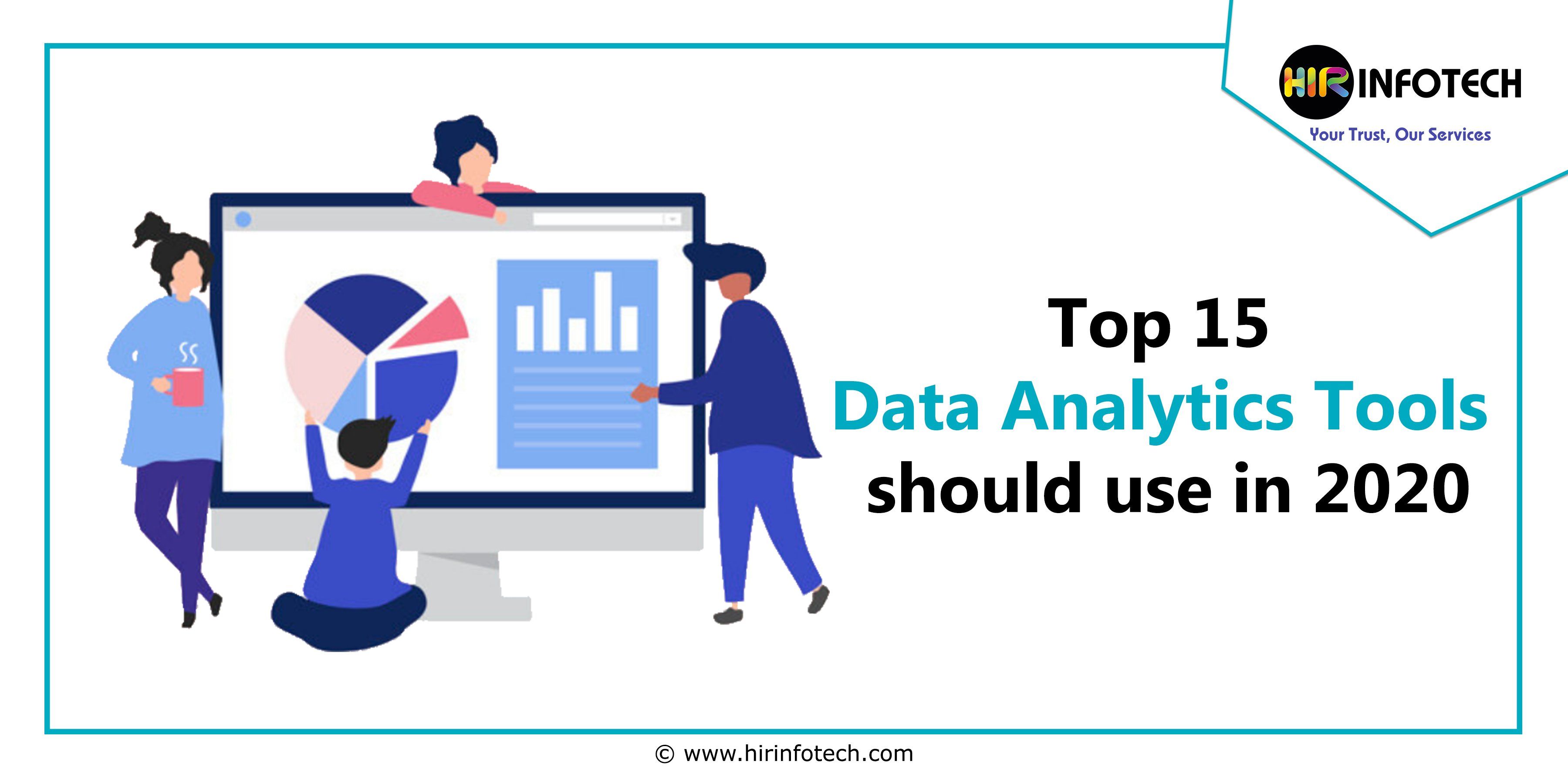Hir Infotech is a leading global outsourcing company with its core focus on offering web scraping, data extraction, lead generation, data scraping, Data Processing, Digital marketing, Web Design & Development, Web Research services and developing web crawler, web scraper, web spiders, harvester, bot crawlers, and aggregators’ softwares. Our team of dedicated and committed professionals is a unique combination of strategy, creativity, and technology.
Data analytics tools can help deliver that value and bring that data to life. A lot of hard work goes into extracting and transforming data into a usable format, but once that’s done, data analytics can provide users with greater insights into their customers, business, and industry.
There are three broad categories of data analytics that offer different levels of insight:
- Traditional Business Intelligence (BI) provides traditional, recurring reports.
- Self-Service Analytics enable end-users to structure their own analyses within the context of IT-provided data and tools.
- Embedded Analytics provides business intelligence within the confines of a traditional business application, like an HR system, CRM, or ERP. These analytics provide context-sensitive decision support within users’ normal workflow.
If you’re not using an analytics tool, you should be. Gartner predicts that by 2020, self-service analytics and BI users will actually produce more analysis than data scientists. No matter what level of insight you need, here are 15 of the best data analytics tools to get you started on your journey, in no particular order.
Data Analytics Tools
Tableau features robust functionality with fast speed to insight. With connectivity to many different local and cloud-based data sources, Tableau’s intuitive interface combines data sourcing, preparation, exploration, analysis, and presentation in a streamlined workflow.
Tableau’s flexibility makes it well-suited to the three types of analytics discussed above. Tableau Server can easily house recurring reports. Power users will appreciate the integrated statistical and geospatial functionality for advanced self-service. And finally, Tableau uses application integration technologies like JavaScript APIs and single sign-on functionality to seamlessly embed Tableau analytics into common business applications.
Looker strives to provide a unified data environment and centralized data governance with a heavy emphasis on reusable components for data-savvy users. Using an extract/load/transform (ELT) approach, Looker gives users the ability to model and transform data as they need it.
Looker also features proprietary LookML language, which harnesses SQL in a visual and reusable way. The reusability concept extends to Looker’s Blocks components, which are reusable utilities for data connections, analysis, visualization, and distribution. Finally, Looker is designed to easily integrate with popular collaboration and workflow tools such as Jira, Slack, and Segment.
BI360 offers modern, dynamic reporting with out-of-the-box integrations to many of the world’s most popular on-premise and cloud-based ERP systems. This easy-to-use report writer offers Excel, web, and mobile interfaces, and provides finance professionals with powerful financial and operational reporting capabilities in a variety of layouts and presentation formats.
BI360 also offers integrated budgeting workflow and analytics, including industry-specific templates. Once you connect data sources to the BI360 Suite, use these templates to access data, collaboratively develop a budget, and display results on predefined dashboards.
Available for cloud and on premise deployment.
Dataiku DSS combines much of the data analysis lifecycle into one tool. It enables analysts to source and prep data, build predictive models, integrate with data mining tools, develop visualizations for end-users and set up ongoing data flows to keep visualizations fresh. DSS’s collaborative environment enables different users to work together and share knowledge, all within the DSS platform.
With its focus on data science, DSS tends to serve deeply analytical use cases like churn analytics, demand forecasting, fraud detection, spatial analytics, and lifetime value optimization.
An open-source, enterprise-class analytics platform, KNIME is designed with the data scientist in mind. KNIME’s visual interface includes nodes for everything from extracting to presenting data, with an emphasis on statistical models. KNIME integrates with several other data science tools including R, Python, Hadoop, and H2O, as well as many structured and unstructured data types.
KNIME supports leading edge, data science use cases such as social media sentiment analysis, medical claim outline detection, market basket analysis, and text mining.
RapidMiner emphasizes speed to insight for complex data science. Its visual interface includes pre-built data connectivity, workflow, and machine learning components. With R and Python integration, RapidMiner automates data prep, model selection, predictive modeling, and what-if gaming. This platform also accelerates “behind-the-scenes” work with a combined development and collaboration environment and integration with Hadoop and Spark big data platforms.
Finally, RapidMiner’s unique approach to self-service utilizes machine learning to glean insight from its 250,000-strong developer community for predictive analytics development. Its context-sensitive recommendations, automated parameter selection, and tuning accelerate predictive model deployment.
Pentaho emphasizes IoT data collection and blending with other data sources like ERP and CRM systems, as well as big data tools like Hadoop and NoSQL. Its built-in integration with IoT endpoints and unique metadata injection functionality speed data collection from multiple sources. Pentaho’s visualization capabilities range from basic reports to complex predictive models.
Pentaho proactively approaches embedded analytics. In addition to investing in integration components like REST APIs, Pentaho’s thorough training and project management methodology help ensure customer success with embedded analytics.
Talend’s toolset is meant to accelerate data integration projects and speed time to value. An open-source tool, Talend comes with wizards to connect to big data platforms like Hadoop and Spark. Its integrated toolset and unique data fabric functionality enable self-service data preparation by business users. By making data prep easier for users who understand the business context for the data, Talend removes the IT bottleneck on clean and usable data, which reduces the time to merge data sources.
Domo focuses on speed to insight for less technical users. It features 500+ built-in data connectors and a visual data prep interface to accelerate data sourcing and transformation. Its robust business intelligence capabilities enable visualization and social commenting to facilitate collaboration. Domo also boasts native mobile device support with the same analysis, annotation, and collaboration experience as desktop.
Domo simplifies remotely embedding analytics using “Cards,” or deployable, interactive visualization portlets. These components integrate with web applications using JavaScript APIs and iframes, and can track utilization by the unique endpoint.
Sisense offers an end-to-end analytics platform with a strong governance component. It offers a visual data sourcing and preparation environment, plus alerts that notify users when a given metric falls outside a configurable threshold. Sisense deploys to on-premises, private-cloud, or Sisense-managed environments, and enables governance at the user role, object, and data levels.
Sisense’s comprehensive approach to embedded analytics includes integration components like JavaScript APIs and single sign-on. But it also enables users to customize embedded visualizations, adding a dimension of self-service to embedded analytics.
Qlik emphasizes speed to insight by automating data discovery and relationships between multiple data sources during data acquisition and preparation. Instead of the traditional query-based approach to acquiring data, Qlik’s Associative Engine automatically profiles data from all inbound sources, identifies linkages, and presents this combined data set to the user. Multiple, concurrent users can quickly explore large and diverse data sets because of Qlik’s in-memory processing architecture, which includes compressed binary indexing, logical inference, and dynamic calculation.
Qlik supports RESTful APIs as well as HTML5 and JavaScript. This support enables web, business application, and mobile platform integration for enterprise-wide embedded analytics.
Founded in 1989, Microstrategy is one of the older data analytics platforms and has the robustness that one would expect from such a mature toolset. Microstrategy connects to numerous enterprise assets like ERPs and cloud data vendors and integrates with multiple common user clients like Android, iOS, and Windows. It also provides a variety of common services such as alerts, distribution, and security, and enables many BI functions like data enrichment, visualization, and user administration.
Microstrategy enhances data governance by using end-point telemetry to manage user access. By gathering location, access, authentication, timestamp, and authorization data, this functionality can help analyze utilization and strengthen security practices.
Thoughtspot features a search engine-like interface and AI to enable users to take a conversational approach to data exploration and analytics. Its SpotIQ engine parses search requests such as “revenue by the country for 2014,” and produces a compelling visualization showing a bar chart ordered least to greatest.
The Thoughtspot platform helps companies quickly deploy this unique approach to analytics with a visual data sourcing and preparation pane, extensive in-memory processing, back-end cluster management for big data environments, centralized row-level security, and built-in embeddable components.
Birst focuses on solving one of the most vexing challenges in data analytics: establishing trust in data from many different sources within the enterprise. Birst’s user data tier automatically sources, maps, and integrates data sources and provides a unified view of the data to users.
Then, using Birst’s Adaptive User Experience, which breaks down the silo between data discovery and dashboarding, users can access the unified data sources to develop analytics with no coding or IT intervention. Finally, Birst enables distribution to multiple platforms and other analytics tools like R and Tableau.
Microsoft SQL Server Reporting Services
SQL Server Reporting Services (SSRS) is a business intelligence and reporting tool that tightly integrates with the Microsoft data management stack, SQL Server Management Services, and SQL Server Integration Services. This toolset enables a smooth transition from the database to the business intelligence environment. SSRS, in particular, offers a visual authoring environment, basic self-service analytics, and the ability to output spreadsheet versions of reports and visualizations.
SSRS and the Microsoft data management stack are the workhorses of traditional BI. They are a mature toolset that performs very well with recurring reports and user-entered parameters.
The well-known vendors above support multiple use cases across many industries. However, the volume of data generated by traditional business activity, social media, and IoT technology continues to explode every year, so data analytics options continue to evolve. With so many options, choosing a vendor can be daunting.
The key to making an informed choice is to understand the unique analytics needs of your organization and industry. Knowing where your needs fall on the analytics spectrum will help you productively engage with vendors – and make the most of the analytics you produce.
Hir Infotech provides web data for analysis using any of these data analytics tools. Contact us to find out more.


